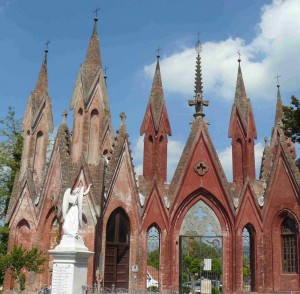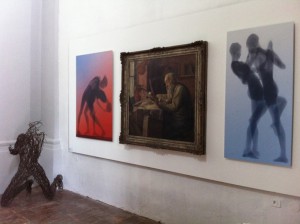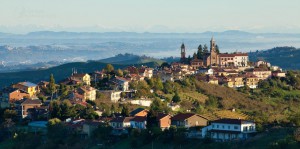Art Itineraries
Langhe has been a place of inspiration both for artists from these hills and for people who arrived here by chance or whilst chasing their muse.
Artists have left us the testimony of their work: architectural projects and works characterize both small villages and lesser known hamlets. Now, it is your turn to be curious, to discover the stories and artistic paths that brought them this far into Langhe to “get lost” amongst the beauty of the gentle slopes or find inspiration for their next work of art.Giovanni Battista Schellino, for example, known as the “Gaudi of Langhe”, was the architect who was able to skilfully build civil buildings and churches standing out for his eclectic and bizarre experimentation. Anyway, Schellino was never really an architect; in fact, he was trained and qualified as a “surveyor”. He was, however, a genius, for his ability to design and build, and his tireless enthusiasm was unmatched.
If he was born in Barcelona, his fame would probably have spread worldwide, but the surveyor Schellino was born, in 1818, in Dogliani, a small town in the south western Langhe. His hometown is full of buildings designed by the architect from Dogliani, starting with Piazza Umberto I, where the parish church dedicated to Saints Quirico and Paul stands out; a huge neoclassical building with a double bell tower and a sky blue dome. Continuing on to Via Savona, one can reach an unusual monumental entrance: the cemetery marked by nine red spires where both Schellino and Luigi Einaudi, influential President of the Italian Republic from 1948 to 1955, are buried. The road leading out of Dogliani, in the direction of Belvedere Langhe, is decorated by thirteen pillars also designed by Schellino: a votive path depicting the Mysteries of the Holy Rosary which accompany the believer up to the Shrine of Our Lady of Grace. The lovely building was an ancient oratory built in the sixteenth century, on a hill from which you can enjoy a wonderful view; in 1873-74, our local architect had the task of restoring it. But there are other works by Schellino: the historic centre of Dogliani retains the original Tower of the Cessi family (1862-1864), the impressive Hospital (1878-1888) and many other architectural remains are present in small villages a few kilometres away such as the parish churches of Cerretto Langhe and Belvedere Langhe, the castle of Novello and the rectory of the chapel of the Holy Trinity in Murazzano. Not far from the most famous holiday resorts, such as Barolo and Monforte, we suggest you stop at the village of Monchiero Alto, a treasure chest of art and beauty that you do not expect. You will be surprised by the tiny hamlet with the green park wrapped in tranquillity and surrounded by the eighteenth-century Sanctuary of Our lady of the Rosary, the former convent and oratory that now houses the art collection of the painter Eso Peluzzi.
Not far from the most famous holiday resorts, such as Barolo and Monforte, we suggest you stop at the village of Monchiero Alto, a treasure chest of art and beauty that you do not expect. You will be surprised by the tiny hamlet with the green park wrapped in tranquillity and surrounded by the eighteenth-century Sanctuary of Our lady of the Rosary, the former convent and oratory that now houses the art collection of the painter Eso Peluzzi.
The portrait and landscape painter Peluzzi, who studied at Accademia Albertina, the Fine Arts Academy of Turin, was born in Cairo Montenotte in 1894 and by 1922 had already made his debut with his first solo exhibition at Società Promotrice di Belle Arti in Turin. Success came to him between 1926 and 1948 with the participation in several editions of the Venice Biennale and numerous Italian exhibitions around Europe; in 1963 he was also appointed Academic of San Luca in Rome. In the 1950s, Eso Peluzzi, now a painter of the divisionism movement, settled in Monchiero Alto and worked here until 1985, the year of his death. Many were the intellectuals and friends who expressed their esteem for him: authoritative writers such as G. Arpino, I. Calvino, G. Lagorio, M. Soldati; art critics L. Carluccio, M. Carra and M. De Micheli, up to Sandro Pertini, President of the Italian republic, who was a great admirer. Today, at the Oratory of Disciplinati, it is possible to admire the art collection of this artist, who was also involved in decorating the Sanctuary that overlooks the lovely little square, where you will find the entrance of a modern hotel, perfectly set in the former convent after a careful restoration. Eso Peluzzi is considered a “cantor” of art, a poet, fond of the representations of family issues, violins and lutes (his father was a very highly valued luthier); his sign is that of a master carefully observant of nature, of the rolling hills of Langhe, for example. Moreover, in still life or snowy landscapes he was capable of transmitting the peace and spiritual beauty of nature. We remain in the hills of Bassa Langa and discover the lands of the Dolcetto wine, visiting the village of Rodello which houses an original museum in the local and national art scene: it is the Museum “Dedalo Montali” of modern and religious art founded in 2003. The museum is spilt over two locations: one is in the Church of the Immaculate Conception and the second is at “La Residenza”, a centre of social services founded in 1967. The two sites are separated but united by a common aim to preserve the 200 paintings and sculptures gathered according to the wishes of the painter Dedalo Montali (Cagliari 1909- Rodello 2001), on the initiative of the widow Taja Satta Montali and Canon Mario Battaglino, founder of “La Residenza” and promoter, in 1964, of an experimental workshop of modern religious art. The association between the Sardinian artist and the village of Rodello began here: in the years after the Second Vatican Council, research was conducted into new artistic languages capable of representing the bond between the Church and contemporary religious art. So, between 1970-72, Dedalo was commissioned by Father M. Battaglino to devise the Chapel of the residence for the elderly in Rodello. The monumental work saw him dealing with the issue of sacred art, telling through 80 m2 of stained glass windows, high reliefs, sculptures, paintings and decorations, the vicissitudes of the industrious life of man, connecting them to the central altar piece where Christ repeats his dinner by sending a message of brotherhood and hope. Do not miss a visit to the baroque Church of the Immaculate Conception, which retains significant works on canvas and sculptures by Montali dedicated to the theme of the Crucifixion. The works are a nod to the Church, heavily singled out because it is no longer able to find answers to a world contaminated by wars, pollution, and where no man can find consolation. Particularly impressive is the large canvas with the “Crucifixion” which fully occupies the room, surrounded by other paintings and sculptures, and the canvas with the dark and stern Bishop depicted seated on a cathedra, a throne, his hand on the Gospels, with his look fixed on a shocked world.
We remain in the hills of Bassa Langa and discover the lands of the Dolcetto wine, visiting the village of Rodello which houses an original museum in the local and national art scene: it is the Museum “Dedalo Montali” of modern and religious art founded in 2003. The museum is spilt over two locations: one is in the Church of the Immaculate Conception and the second is at “La Residenza”, a centre of social services founded in 1967. The two sites are separated but united by a common aim to preserve the 200 paintings and sculptures gathered according to the wishes of the painter Dedalo Montali (Cagliari 1909- Rodello 2001), on the initiative of the widow Taja Satta Montali and Canon Mario Battaglino, founder of “La Residenza” and promoter, in 1964, of an experimental workshop of modern religious art. The association between the Sardinian artist and the village of Rodello began here: in the years after the Second Vatican Council, research was conducted into new artistic languages capable of representing the bond between the Church and contemporary religious art. So, between 1970-72, Dedalo was commissioned by Father M. Battaglino to devise the Chapel of the residence for the elderly in Rodello. The monumental work saw him dealing with the issue of sacred art, telling through 80 m2 of stained glass windows, high reliefs, sculptures, paintings and decorations, the vicissitudes of the industrious life of man, connecting them to the central altar piece where Christ repeats his dinner by sending a message of brotherhood and hope. Do not miss a visit to the baroque Church of the Immaculate Conception, which retains significant works on canvas and sculptures by Montali dedicated to the theme of the Crucifixion. The works are a nod to the Church, heavily singled out because it is no longer able to find answers to a world contaminated by wars, pollution, and where no man can find consolation. Particularly impressive is the large canvas with the “Crucifixion” which fully occupies the room, surrounded by other paintings and sculptures, and the canvas with the dark and stern Bishop depicted seated on a cathedra, a throne, his hand on the Gospels, with his look fixed on a shocked world. The next stop is in Montelupo Albese, a village located 564m above sea level which, for lovers of outdoor walks can also be reached on foot through well-marked trails. The name of the village has its roots in a legend that has to do with the heights and with animals, or perhaps wolves, the first “inhabitants” of these hills. Thanks to a project started in 2011, you can visit the village and its surrounding hamlets following the thread of a path consisting of murals that feature the wolf, in Latin “Lupus in fabula”, “Speak of the devil”, indeed. The wolf is a menacing and legendary animal, once widespread in the Italian peninsula, which has often populated peasants’ tales and disturbed children’s dreams. The route is constantly changing and from 2011, artists from various parts of Italy, with imagination and competence, have drawn on the walls of the houses the literary image and fables of this mammal, creating in the streets of the town a fairy tale atmosphere. You will meet “Saint Francis and the wolf of Gubbio,” “The Wolf and the Seven Young Goats” and the more contemporary murals of the “Blue Haired Wolf”. The starting point is Piazza Castello, from which, following the signs “a testa di lupo” you can follow circular-itineraries also dedicated to truffles, orchids, etc. The panoramic view offers memorable glimpses of the hazel groves of Alta Langa and the manicured vineyards of the Bassa Langa, and up to, on very clear days, the entire western Alps with Monviso, Monte Rosa and the Matterhorn.
The next stop is in Montelupo Albese, a village located 564m above sea level which, for lovers of outdoor walks can also be reached on foot through well-marked trails. The name of the village has its roots in a legend that has to do with the heights and with animals, or perhaps wolves, the first “inhabitants” of these hills. Thanks to a project started in 2011, you can visit the village and its surrounding hamlets following the thread of a path consisting of murals that feature the wolf, in Latin “Lupus in fabula”, “Speak of the devil”, indeed. The wolf is a menacing and legendary animal, once widespread in the Italian peninsula, which has often populated peasants’ tales and disturbed children’s dreams. The route is constantly changing and from 2011, artists from various parts of Italy, with imagination and competence, have drawn on the walls of the houses the literary image and fables of this mammal, creating in the streets of the town a fairy tale atmosphere. You will meet “Saint Francis and the wolf of Gubbio,” “The Wolf and the Seven Young Goats” and the more contemporary murals of the “Blue Haired Wolf”. The starting point is Piazza Castello, from which, following the signs “a testa di lupo” you can follow circular-itineraries also dedicated to truffles, orchids, etc. The panoramic view offers memorable glimpses of the hazel groves of Alta Langa and the manicured vineyards of the Bassa Langa, and up to, on very clear days, the entire western Alps with Monviso, Monte Rosa and the Matterhorn.
Wine Cellars Along the Itinerary
Marziano Abbona
, Borgata San Luigi 40, Dogliani CNBottega del Vino Dogliani
, P.zza San Paolo, 9, Dogliani CNPoderi Luigi Einaudi
, Borgata Gombe, 31, Dogliani CNPlaces to Eat Along the Itinerary
Accommodation Along the Itinerary
Hotel Ristorante Ca’ del Lupo
, Via Ballerina, 14/16, Montelupo Albese CNPoderi Luigi Einaudi
, Borgata Gombe, 31, Dogliani CN




